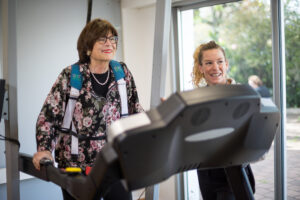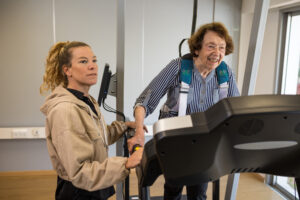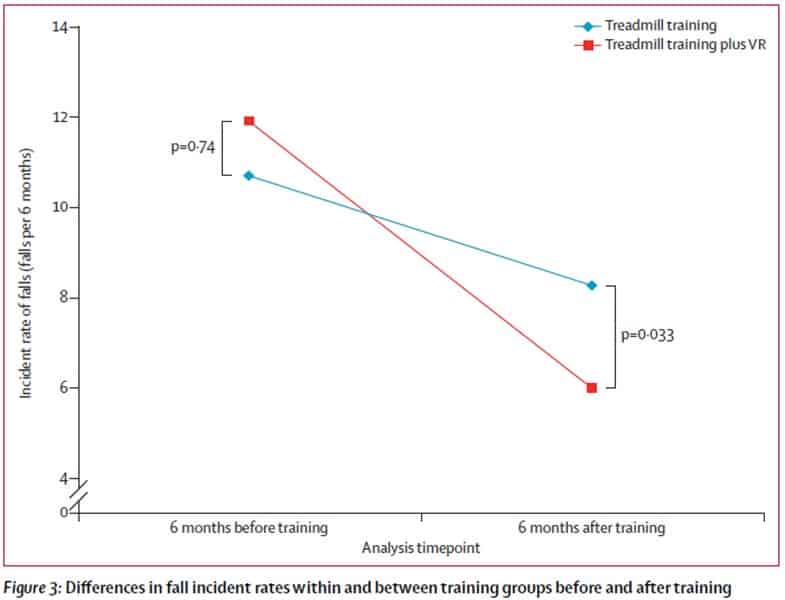The Value of Virtual Reality in Gait Training
An increasing number of clinics, centers, and senior living facilities are adopting virtual reality (VR) to enhance gait training in their practices. Indications they are treating with VR include:
Idiopathic (Aging)
Balance Issues (Vestibular)
Parkinson’s Disease
Multiple Sclerosis
Stroke
Partial spinal cord injury
Traumatic brain injury
Post fractures
Joint replacement
The positive outcomes are growing and findings are showing improved gait, confidence and overall well-being of patients. The value is immense in all aspects, for the patient, the therapist and the business.
With quicker rehabilitation times, reduced falls, and optimized training sessions, this means a perfect solution for everyone.

What is virtual reality in rehabilitation?
Virtual reality (VR) rehabilitation, also known as immersive multimedia, is a computer-simulated real or imaginary environment.
VR rehabilitation is a proven solution for engaging users in a comfortable and safe environment to accelerate rehabilitation, especially cognition and gait.
By using virtual technology the individual’s experience can be personalized based on age, weight, injury, functional level, etc. As a result, the possibilities are quite endless and the results outstandingly great.
An example of virtual reality in rehabilitation is a VR add-on to treadmills that improves gait by drastically reducing the risk of falls. (1) The VR environment presents the patient with obstacles that provide motor–cognitive training and improve gait.
Furthermore, studies are showing that VR training results in significantly better outcomes compared with the conventional physical therapy in patients with balance disturbances and vestibular dysfunction, such as in Parkinson’s disease. (2)
This shows that VR rehabilitation may be used to treat a wide range of problems in the patients suffering from gait impairments.
What are the advantages of virtual reality in gait training?
Let’s dig in a little deeper on the advantages of virtual reality for therapy.
By practicing real-world situations and challenges in a safe and controlled environment, patients gain confidence at a rapid rate. This improves transfer of acquired skills to daily activities and improved gait.
The practice of repetitive tasks and challenges allows the therapist to objectively and quantitatively measure and assess a patient’s progress over time.
Therapists are easily able to diversify the training, keeping patients more engaged throughout the gait rehabilitation program. Virtual reality is a fun way to build motivation and reduce self-discharge.
Virtual reality can not only improve gait, but also cognitive abilities. By focusing on certain tasks and obstacles, patients are training the brain as well.
VR treadmill gait rehabilitation also works on motor planning, spatial awareness, decision making, memory, motivation, self-awareness and multi-tasking.
Furthermore, virtual reality systems can be set up quickly and specific to that patient. This may shorten the overall set up time, resulting in longer and more optimized training sessions. This is a cost effective solution for both sides.
When considering a VR add-on to treadmills, it is important to select those, such as the GaitBetter VR system, that come equipped with a safety harness. This adds to the comfort of the patient, increasing their confidence in walking on the treadmill.

Advanced virtual reality-based rehabilitation of balance and gait in clinical practice
Whether you are a hospital, physical therapy clinic or assisted living home, the VR add-on to treadmills is an ideal solution for gait and cognitive rehabilitation.
Data shows that by introducing virtual reality in comparison to conventional treadmill training, gait rehabilitation improves immensely.
One such study found that incorporating virtual reality into treadmill training increased walking speed and motivation (3)
The performance of the GaitBetter prototype “V-TIME” was recently reviewed and published in Nature Reviews Neurology. The authors noted that “much unrealized potential exists for the use of VR to provide personalized assessment and rehabilitation that optimizes motor learning in both the clinic and home environments and adapts to changes in individuals over time.” Furthermore, it was stated that “the largest and most comprehensive trial to date (the V- TIME trial) did report some important extra benefits of VR” in comparison to non-immersive VR systems. (4)

GaitBetter virtual reality rehabilitation system
The GaitBetter smart VR technology with a proven 50% reduction in falls is a quick and easy solution for your practice that works with almost any treadmill. Save time, build confidence and motivation in your patients quicker and GaitBetter sooner!
Are you ready to GaitBetter? Schedule a meeting with us today! Click Here.
